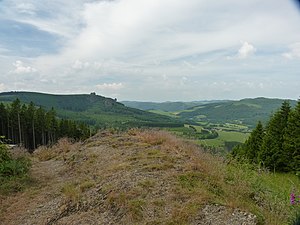Gorse head
| Gorse head | ||
|---|---|---|
|
View to the southwest past the Bruchhauser stones ; |
||
| height |
663.3 m above sea level NHN (southern tip) ; 661 m (middle crest) ; approx. 640 m (north tip) |
|
| location | between Brilon-Wald and Elleringhausen ; Hochsauerlandkreis , North Rhine-Westphalia ( Germany ) | |
| Mountains | Rothaar Mountains | |
| Dominance | 1.17 km → Rehkopf | |
| Notch height | 82.7 m ↓ north of the Schusterknapp (to Borberg ) | |
| Coordinates | 51 ° 20 '8 " N , 8 ° 34' 1" E | |
|
|
||
The gorse head between Brilon-Wald and Elleringhausen in the North Rhine-Westphalian Hochsauerlandkreis is 663.3 m above sea level. NHN high mountain in the Rothaar Mountains .
geography

location
The in Sauerland Ginsterkopf located is located in the northeast part of the Rothaar west of the Valley of the Hoppecke located Brilon-Wald (Southern District of Brilon ) and east of the valley of greed Kopp Bach located Elleringhausen (south-eastern district of Olsberg ), where the border between the two cities on its summit runs.
Natural allocation
The gorse head belongs to the natural spatial main unit group Süderbergland (No. 33), in the main unit Rothaargebirge (with Hochsauerland ) (333) and in the subunit Hochsauerländer Schluchtgebirge (333.8) to the natural area Habuch (333.83), whereby its area in the west into the natural area Ramsbecker Ridge and gorges (333.81) and in the southwest into the natural area Bödefelder Mulde (with Assinghauser Grund) (333.80).
Mountain heights and crests
The south knoll ( ⊙ ) of the gorse head, which is unnamed on many maps, is 663.3 m high according to an altitude indicated on topographical maps , the middle knoll , usually labeled with gorse head ( ⊙ ) according to an altitude stated on this map, is 661 m and the again unnamed north knoll ( ⊙ ) according to the top contour line visible there at least 640 m .
Between southern and central dome is an 621.3 m high notch and between the middle and north summit a 618 m high notch. Both make it clear that there are not three different mountains, as the heights of the notches are only a few meters below the three summit peaks.
Near the 661.0 m high central dome of the Gorse Head, topographic maps show a 657.3 m high point.
Rhine-Weser watershed
The Rhine-Weser watershed runs over the Ginsterkopf and the Habberg ( 653.3 m ) to the north : While the water of the Gierskoppbach flowing to the west drains into the Rhine through the Ruhr , that of the Hoppecke to the east runs through the Diemel into the Weser . The small Gierskoppbach tributary Habbecke rises in the transition area between the two mountains and the Düsmecke on the western flank of the Ginsterkopf- Südkuppe as a tributary of the Limmecke (Limmeke) . The Hoppecke tributary Schmala (Schmalah, Schellhornbach) flows southeast of this crest .
Protected areas
The Hoppecke-Diemel-Bergland landscape protection area <landscape type A> ( CDDA no. 345020; designated in 1989; 78.03 km² in size) lies on the eastern areas of the Ginsterkopf and the LSG Olsberg (CDDA no. 345105; 2004; 79 , 52 km²).
Traffic and walking
East of the Ginsterkopf runs in the valley of the Hoppecke through Brilon-Wald the federal road 251 and south, southwest and west of Brilon-Wald to and through Elleringhausen along the Schmala and Gierskoppbach the state road 743. The 1,393 m long Elleringhäuser runs through the transition area to the Habberg Tunnel of the Upper Ruhr Valley Railway . The Rothaarsteig runs over the western high elevations of the Ginsterkopf and the 1.6 km long byway climbing variant Ginsterkopf runs over the ridge with the summit . Several paths lead to the summit.
Individual evidence
- ↑ a b c d e f Map services of the Federal Agency for Nature Conservation ( information )
- ↑ a b c d Topographical Information Management, Cologne District Government, Department GEObasis NRW ( information )
- ↑ Martin Bürgener: Geographical Land Survey: The natural spatial units on sheet 111 Arolsen. Federal Institute for Regional Studies, Bad Godesberg 1963. → Online map (PDF; 4.1 MB)

